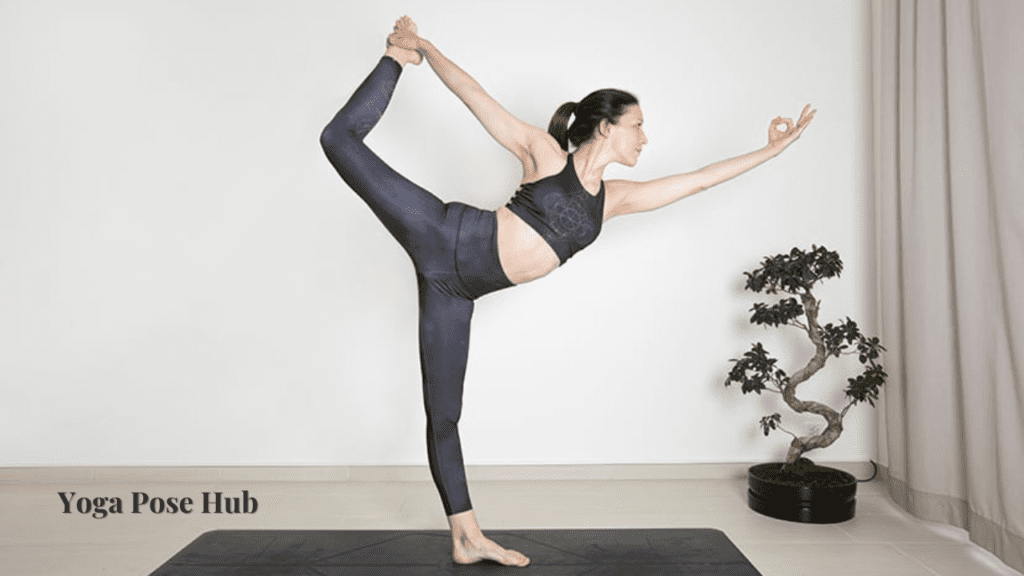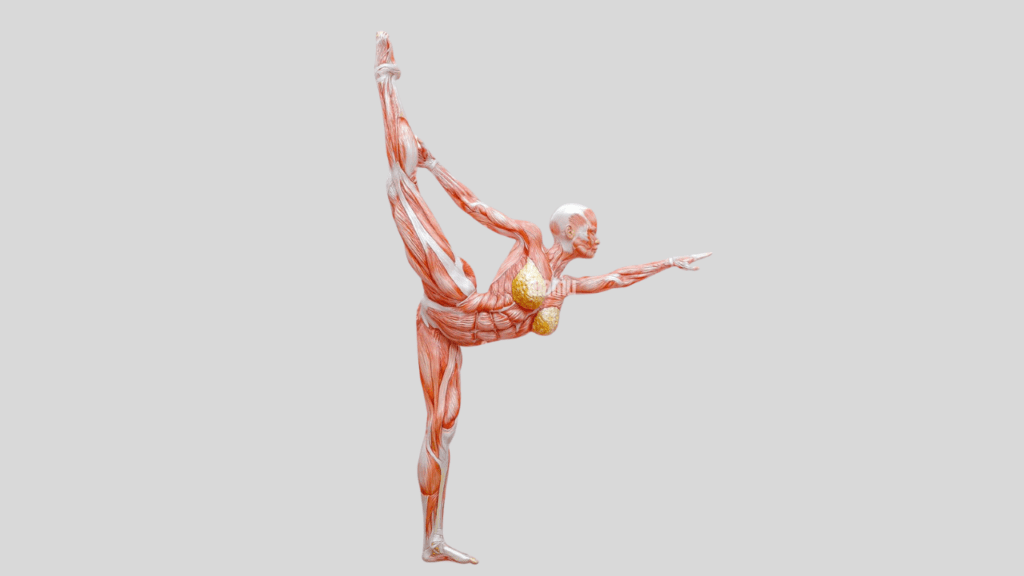If you’re looking to upload a dash of beauty and power to your yoga exercise, the Standing Bow Pose might simply be your new satisfactory buddy. This pose, referred to as “Dandayamana Dhanurasana” in Sanskrit, is a staple in many yoga lessons for its particular aggregate of balance, flexibility, and attention. Imagine status tall, one leg kicked lower back and up, your hand attaining for your foot, forming a lovely bow form with your frame. Sounds awesome, right? But don’t fear—it’s no longer as intimidating as it seems. With a touch of practice and endurance, you’ll be putting this pose like a seasoned!
Target: Legs

What Is Standing Bow Pose?
The Standing Bow Pose(Natarajasana)is a powerful standing stability posture that requires you to stabilize on one leg while lifting the other leg in the back of you, retaining it with one or both fingers. Your frame leans ahead, developing a swish arch that resembles a bow being drawn, therefore the name. This pose is amazing for enhancing balance, flexibility, and awareness, making it a favorite among yogis of all levels. Plus, it appears relatively cool!
Warmup Before Yoga
Warming up before yoga is important for getting ready your body and mind for exercise. A right heat-up facilitates boom blood go with the flow in your muscle groups, making them greater flexible and reducing the hazard of damage. It additionally loosens up your joints and receives your heart fee up, which facilitates improved overall performance at some point in your yoga consultation. Simple sporting events like gentle stretches, arm swings, or light strolling let you ease into your exercise, making it more exciting and effective. Remember, taking a few minutes to warm up could make a huge difference in how you sense during and after your yoga routine!
How to Perform the Standing Bow Pose
Ready to offer it an attempt? Here’s a step-by-step guide that will help you master the Standing Bow Pose:
- Start in Mountain Pose: Begin by way of status tall in Mountain Pose (Tadasana), together with your feet hip-width aside and your arms comfortable with the aid of your facets.
- Shift Your Weight: Slowly shift your weight onto your right foot. Engage your middle and hold your proper leg strong and consistent.
- Find Your Balance: Once you have a firm grip on your foot, begin to raise it better at the back of you. At the same time, reach your right arm forward, keeping it parallel to the floor.
- Kick and Stretch: Kick your left foot returned and up as you lean your torso ahead. Keep your chest lifted and gaze ahead. Your body should form a bow shape, along with your left leg performing as the string being pulled.
- Hold the Pose: Hold the pose for 20-30 seconds, respiratory deeply. Focus on a point in the front of you to help hold your balance.
- Release and Repeat: To launch the pose, slowly lower your left foot back to the ground and go back to Mountain Pose. Repeat on th
Curious about more yoga poses? Check out our detailed guide on “Wild Thing Pose” for another enriching addition to your practice!
Benefits of Standing Bow Pose
Why ought to you encompass the Standing Bow Pose in your yoga normal? The blessings are severa!
- Enhances Balance: This pose is an outstanding way to beautify your balance and balance. Balancing on one leg is a good way to engage your core and interest your thoughts, helping you increase both intellectual and physical balance.
- Improves Flexibility: By stretching your shoulders, chest, and hip flexors, the Standing Bow Pose helps growth flexibility in these regions. It’s mainly beneficial for those who spend numerous time sitting, because it counteracts the consequences of extended sitting to your frame.
- Strengthens Muscles: This pose engages numerous muscle organizations, including the thighs, glutes, middle, and back muscular tissues, supporting to tone and toughen them.
- Boosts Focus and Concentration: Balancing poses like the Standing Bow Pose requires excessive awareness, and support to sharpen your recognition and mental readability.
Tips for Beginners
If you are new to the Standing Bow Pose, it’s every day to experience a bit wobbly at the beginning. Here are a few guidelines to help you discover your stability:
- Use a Wall: Practice the pose close to a wall for help. You can use the wall to help you stabilize as you elevate your leg.
- Focus Your Gaze: Fix your gaze on a component in front of you to help preserve your stability. This is called a “drishti” in yoga, and it may be particularly beneficial in balancing poses.
- Don’t Rush: Take some time to find out your stability and lift your leg. There’s no want to hurry—exercise makes it ideal!
Common Mistakes to Avoid
As you practice the Standing Bow Pose, understand those common errors to make certain you are doing it safely and efficiently:
- Overarching the Back: Avoid overarching your back as you carry your leg. Instead, recognition on maintaining your chest lifted and your spine lengthy.
- Letting the Standing Knee Collapse: Make sure to maintain your status knee immediately and robustly. Letting it fall apart can result in injury.
- Losing Alignment: Keep your hips squared and keep away from twisting your frame. This will assist you to maintain proper alignment and stability.
Curious about more yoga poses? Check out our detailed guide on “Serpentine Yoga Pose” for another enriching addition to your practice!
Modifications and Variations
The Standing Bow Pose may be challenging, particularly for novices. Here are some adjustments and variations that will help you work as much as the entire pose:
- Use a Strap: If you have tight shoulders or hamstrings, use a yoga strap that will help you reach your foot. Loop the strap around your foot and keep it together with your hand.
- Half Standing Bow Pose: If you’re struggling to stabilize, exercise the Half Standing Bow Pose. Instead of lifting your leg excessively, keep it lower and attention to finding your balance.
Incorporating Standing Bow Pose into Your Practice
Now that you recognize a way to carry out the Standing Bow Pose, you might be thinking of a way to incorporate it into your yoga exercise. Here are some minds:
- As a Warm-Up: Include the Standing Bow Pose on your warm-up habit to help beautify your balance and versatility in advance before shifting on to tougher poses.
- In a Vinyasa Flow: Use the Standing Bow Pose as a transition amongst exceptional fame poses, like Warrior II or Triangle Pose. This will help preserve your exercise dynamic and tasty
TargetPoints

Curious about more yoga poses? Check out our detailed guide on “Warrior I” for another enriching addition to your practice!
Conclusion
Incorporating the Standing Bow Pose into your yoga exercise can provide quite a variety of physical and mental blessings. Whether you’re a newbie or a professional yogi, this pose is a brilliant way to undertake yourself and enhance your exercise.
- Start slow: Use modifications and build up your electricity and versatility.
- Stay targeted: Keep your gaze steady to hold your balance.
- Practice regularly: Consistency will help you beautify and enjoy the advantages of the pose.
Now it’s miles your flip! Grab your mat and give the Standing Bow Pose a strive. Remember, yoga is all approximately exercising, patience, and locating pleasure in each motion. Namaste!
Some Common Questions
How long should I hold the Standing Bow Pose?
Hold the pose for 20-30 seconds on each side, or longer if you’re comfortable. Make sure to breathe deeply and focus on maintaining your balance.
Can beginners do the Standing Bow Pose?
Yes! Beginners can practice the Standing Bow Pose with modifications, such as using a wall for support or holding onto a strap.
What muscles does the Standing Bow Pose work?
The Standing Bow Pose works various muscle groups, including the thighs, glutes, core, back, shoulders, and hip flexors.
Can I practice the Standing Bow Pose if I have tight hamstrings?
Yes! If you have tight hamstrings, use a yoga strap to help you reach your foot and gradually work on increasing your flexibility.
Can I practice the Standing Bow Pose during pregnancy?
It’s generally recommended to avoid the Standing Bow Pose during pregnancy, especially as your belly grows since it involves balancing on one leg and leaning forward, which can be challenging. Instead, consider practicing more stable and gentle poses that help you maintain balance and comfort. Always consult with your healthcare provider or a prenatal yoga instructor before trying any yoga poses during pregnancy.